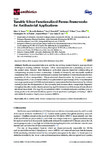Tunable Silver-Functionalized Porous Frameworks for Antibacterial Applications
| dc.contributor.author | Isaacs, M | |
| dc.contributor.author | Barbero, B | |
| dc.contributor.author | Durndell, Lee | |
| dc.contributor.author | Hilton, A | |
| dc.contributor.author | Olivi, L | |
| dc.contributor.author | Parlett, C | |
| dc.contributor.author | Wilson, K | |
| dc.contributor.author | Lee, A | |
| dc.date.accessioned | 2019-11-18T13:05:28Z | |
| dc.date.issued | 2018-07-03 | |
| dc.identifier.issn | 2079-6382 | |
| dc.identifier.issn | 2079-6382 | |
| dc.identifier.other | ARTN 55 | |
| dc.identifier.uri | http://hdl.handle.net/10026.1/15157 | |
| dc.description.abstract |
Healthcare-associated infections and the rise of drug-resistant bacteria pose significant challenges to existing antibiotic therapies. Silver nanocomposites are a promising solution to the current crisis, however their therapeutic application requires improved understanding of underpinning structure-function relationships. A family of chemically and structurally modified mesoporous SBA-15 silicas were synthesized as porous host matrices to tune the physicochemical properties of silver nanoparticles. Physicochemical characterization by transmission electron microscopy (TEM), X-ray diffraction (XRD), X-ray photoelectron spectroscopy (XPS), X-ray absorption near-edge spectroscopy (XANES) and porosimetry demonstrate that functionalization by a titania monolayer and the incorporation of macroporosity both increase silver nanoparticle dispersion throughout the silica matrix, thereby promoting Ag₂CO₃ formation and the release of ionic silver in simulated tissue fluid. The Ag₂CO₃ concentration within functionalized porous architectures is a strong predictor for antibacterial efficacy against a broad spectrum of pathogens, including C. difficile and methicillin-resistant Staphylococcus aureus (MRSA). | |
| dc.format.extent | 55-55 | |
| dc.format.medium | Electronic | |
| dc.language | en | |
| dc.language.iso | en | |
| dc.publisher | MDPI | |
| dc.subject | silver | |
| dc.subject | antibacterial | |
| dc.subject | titania | |
| dc.subject | mesoporous | |
| dc.subject | macroporous | |
| dc.subject | surface functionalization | |
| dc.title | Tunable Silver-Functionalized Porous Frameworks for Antibacterial Applications | |
| dc.type | journal-article | |
| dc.type | Journal Article | |
| plymouth.author-url | https://www.webofscience.com/api/gateway?GWVersion=2&SrcApp=PARTNER_APP&SrcAuth=LinksAMR&KeyUT=WOS:000457061900005&DestLinkType=FullRecord&DestApp=ALL_WOS&UsrCustomerID=11bb513d99f797142bcfeffcc58ea008 | |
| plymouth.issue | 3 | |
| plymouth.volume | 7 | |
| plymouth.publication-status | Published online | |
| plymouth.journal | Antibiotics | |
| dc.identifier.doi | 10.3390/antibiotics7030055 | |
| plymouth.organisational-group | /Plymouth | |
| plymouth.organisational-group | /Plymouth/Faculty of Science and Engineering | |
| plymouth.organisational-group | /Plymouth/Faculty of Science and Engineering/School of Geography, Earth and Environmental Sciences | |
| plymouth.organisational-group | /Plymouth/REF 2021 Researchers by UoA | |
| plymouth.organisational-group | /Plymouth/REF 2021 Researchers by UoA/UoA12 Engineering | |
| plymouth.organisational-group | /Plymouth/Users by role | |
| plymouth.organisational-group | /Plymouth/Users by role/Academics | |
| dc.publisher.place | Switzerland | |
| dcterms.dateAccepted | 2018-07-02 | |
| dc.rights.embargodate | 2019-11-19 | |
| dc.identifier.eissn | 2079-6382 | |
| dc.rights.embargoperiod | Not known | |
| rioxxterms.versionofrecord | 10.3390/antibiotics7030055 | |
| rioxxterms.licenseref.uri | http://www.rioxx.net/licenses/all-rights-reserved | |
| rioxxterms.licenseref.startdate | 2018-07-03 | |
| rioxxterms.type | Journal Article/Review |


